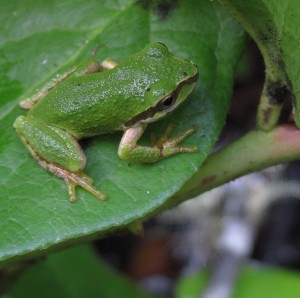
From all across the Peninsula they came: High schoolers from Menlo Park, mothers from San Jose, and students from Stanford joining together to count the species at Stanford’s Lake Lagunita during the university’s annual BioBlitz event.
Along their trek, the nearly 50 volunteers noted many common animal species, but some of the water-dependent creatures were notably missing, including the California tiger salamander. Literally the poster child of the event, the salamander eluded detection on the driest year the peninsula has seen in almost four decades.
Last year, volunteers tallied over 100 species of plants and animals on BioBlitz day. “People are astounded when I tell them we’ve found over fifty species of birds here,” said Kate Lowry, an oceanography graduate student at Stanford who helps organize the survey of campus biodiversity each year.
This year, Lowry said the bird counts fell by half, from more than 50 to just 26.
In part, Lowry ascribed the lowered counts to BioBlitz Day’s hot weather, which could have driven many animals into hiding. But Audubon Society bird guide and Stanford biology graduate student Robert Furrow said the unusually dry year is pushing some birds out of the area all together.
“There aren’t nearly as many insects – especially ones that hatch from water” for migratory birds to feed on, Furrow explained. And water-dependent breeders like ducks and geese are nesting elsewhere.
The California tiger salamander is endangered in parts of its range and threatened on the Peninsula. In wetter years, the salamanders breed in vernal pools – which, like Lagunita, fill during the rainy season but dry down over the summer.
Drought didn’t always mean a lost year of salamander and bird breeding at Lake Lagunita. For decades, Stanford carefully regulated lake’s water level by topping up the basin with water from San Francisquito Creek. “Up until the ‘80s and ‘90s, the university actually held sailing and windsurfing lessons on the lake,” said Carol Boggs, an ecologist at Stanford. “It was basically run as a recreational site, and drained the day after graduation.”
Now, the university lets Lagunita fill only with rainwater that runs off the foothills, Stanford water supply manager Thomas Zigterman explained.
There’s not much of that runoff during an extreme drought year like this one, in which San Jose has received only half its normal rainfall. According to National Weather Service data, the last twelve months have been the driest since 1975.
Even though Stanford is “literally managing Lagunita for the salamander,” Boggs said, it doesn’t necessarily make sense to fill the lake with diverted San Francisquito Creek water because another threatened species – the steelhead salmon – lives and breeds in the lower reaches of the creek. The fish need a minimum amount of water to survive, and this year, Boggs said, “there simply wasn’t enough water in San Francisquito Creek” to think about diverting any of it.
But all is not lost with one dry season. “Luckily, the important creeks stayed wet,” Furrow said, so Lagunita’s missing birds likely found nest sites elsewhere. And tiger salamanders can live from 12 to 14 years, Boggs said, so most of the population should just sleep this drought away.
However, scientists predict that climate change will bring wilder swings in annual rainfall to the Bay Area, which means more drought years are likely. While migratory birds should be able to relocate to greener pastures, no one is sure what climate change will mean for the tiger salamander.
“Obviously, their population will take a hit for every dry year,” Boggs said.
For now, bird and salamander populations seem to be holding steady. But if dry years become more prevalent, there may come a time when, no matter how much rain falls or Stanford pumps, there are no tiger salamanders left to crawl from their burrows and migrate to their seasonal breeding pools. And the BioBlitzers, on their annual count, will be among the first to know.
